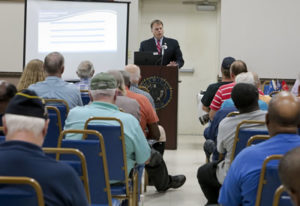
This summer, the Carl Vinson VAMC in Georgia held a special town hall at an American Legion post to share information on the MISSION Act and how it will change VA care. Marine Corps photo by Re-Essa Buckels
WASHINGTON—Three months following the implementation of the MISSION Act, VA leaders testified before Congress that the sweeping changes to the agency’s community care standards are rolling out smoothly. Concerns remain, however, about veterans’ lack of understanding of the program and community providers not living up to VA standards.
Just 90 days into the rollout, over 1.2 million veterans had consulted with VA clinicians about receiving community care services, explained Richard Stone, MD, executive-in-Charge of VHA. During those consultations VA providers used the decision support tool —the online tool designed to help determine whether a veteran is eligible for community care—more than a million times.
In fact, according to VA officials, the DST is now being used an average of 30,000 times a day. Concerns about the DST prior to the rollout in terms of its functionality and how easy it would be for providers to understand and use appear to have been premature, Stone said.
“This is a department that hasn’t had a great track record rolling out new software systems that we developed ourselves. I think the concern was well-placed,” Stone told legislators. “But using an agile development model and the utilization of the joint operations center that gives complete visibility across the nation on performance in all areas at all times of the day has allowed not only the implementation of the DST but also the ability to use the decision support tool and update it.”
On Oct. 1, VA released the 13th update to the DST since its launch on June 6—a sign that VA is committed to improving the system, Stone explained. “We are continuing to respond to the needs of clinicians and concerns of clinicians.”
Continue Reading this Article: Privatization Concerns


My experience with using Care in the Community over a half-dozen times is it takes on average six months to get an appointment. I am not aware what the standards for Care in the Community to schedule an appointment! I do support this program but it is a typical VA program that’s definition of success is vague at best!
The system is a disaster and wastes time for providers and veterans. Sometimes the vet waits longer for a community appointment or the community provider never gets them scheduled. Then they repeat tests that have already been done and do not communicate with the VA provider. We need to fund VA care so that VA can hire the providers it needs and care for the vets the way it was intended.